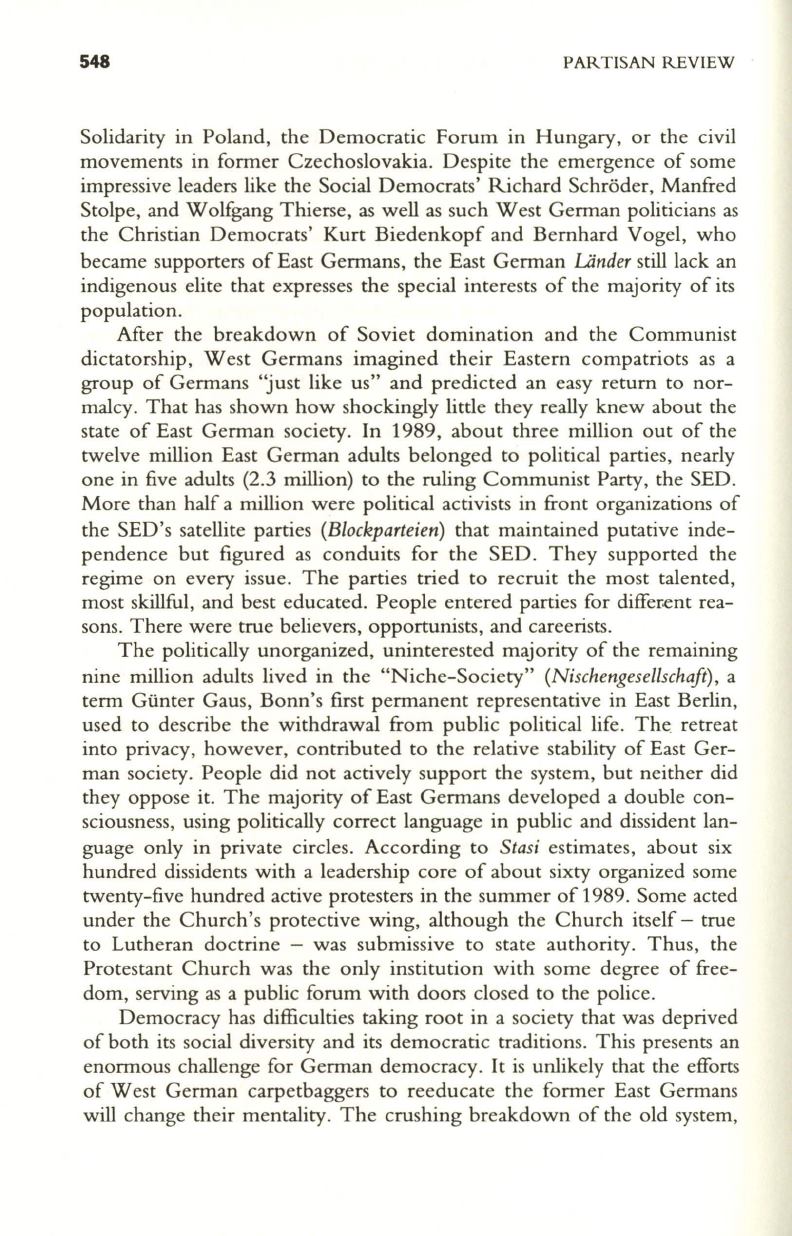
548
PARTISAN REVIEW
Solidarity in Poland, the Democratic Forum in Hungary, or the civil
movements in former Czechoslovakia. Despite the emergence of some
impressive leaders like the Social Democrats' Richard Schroder, Manfred
Stolpe, and Wolfgang Thierse, as well as such West German politicians as
the Christian Democrats' Kurt Biedenkopf and Bernhard Vogel, who
became supporters of East Germans, the East German
Lander
still lack an
indigenous elite that expresses the special interests of the majority of its
population.
After the breakdown of Soviet domination and the Communist
dictatorship, West Germans imagined their Eastern compatriots as a
group of Germans "just like us" and predicted an easy return to nor–
malcy. That has shown how shockingly little they really knew about the
state of East German society. In 1989, about three million out of the
twelve million East German adults belonged to political parties, nearly
one in five adults (2.3 million) to the ruling Communist Party, the SED.
More than half a million were political activists in front organizations of
the SED's satellite parties
(Blockparteien)
that maintained putative inde–
pendence but figured as conduits for the SED. They supported the
regime on every issue. The parties tried to recruit the most talented,
most skillful, and best educated. People entered parties for different rea–
sons. There were true believers, opportunists, and careerists.
The politically unorganized, uninterested majority of the remaining
nine million adults lived in the "Niche-Society"
(Nischengesellschaft),
a
term Gunter Gaus, Bonn's first permanent representative in East Berlin,
used to describe the withdrawal from public political life. The retreat
into privacy, however, contributed to the relative stability of East Ger–
man society. People did not actively support the system, but neither did
they oppose it. The majority of East Germans developed a double con–
sciousness, using politically correct language in public and dissident lan–
guage only in private circles. According to
Stasi
estimates, about six
hundred dissidents with a leadership core of about sixty organized some
twenty-five hundred active protesters in the summer of 1989. Some acted
under the Church's protective wing, although the Church itself - true
to Lutheran doctrine - was submissive to state authority. Thus, the
Protestant Church was the only institution with some degree of free–
dom, serving as a public forum with doors closed to the police.
Democracy has difficulties taking root in a society that was deprived
of both its social diversity and its democratic traditions. This presents an
enormous challenge for German democracy. It is unlikely that the efforts
of West German carpetbaggers to reeducate the former East Germans
will change their mentality. The crushing breakdown of the old system,


